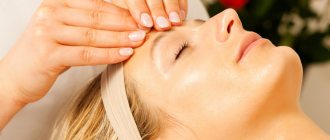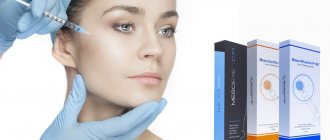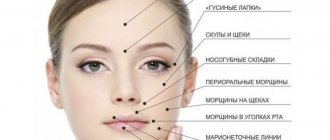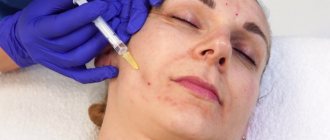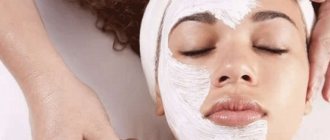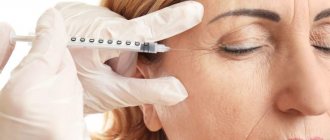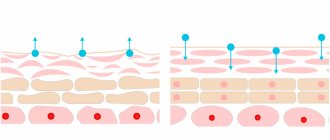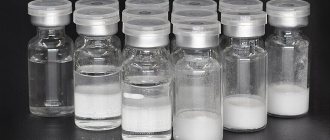How many types of mesotherapy are there, what “beauty injections” should it be combined with, and can a mesoroller replace a salon procedure? Cosmetologist Sergey Barsukov (@sergeybarsukoff) - about ten important facts you need to know about mesotherapy.
Sergey Barsukov
Cosmetologist-dermatologist at the Romanov Beauty and Health Center
Mesotherapy is injections of active substances (hyaluronic acid, phospholipids, vitamins, minerals, acids, etc.) carried out intradermally by a cosmetologist. These components are present in almost all creams, gels and serums, but they cannot penetrate into the deep layers of the skin - this is why mesotherapy is needed. It is she who helps the necessary components reach the place where they are so lacking. Thanks to this, the skin acquires a more youthful, toned appearance, it is filled with freshness and becomes toned.
This procedure has been pleasing girls since the mid-20th century, medications are constantly being improved, and mesotherapy is becoming an increasingly effective procedure. In addition, it stimulates metabolic processes in skin cells, activates natural collagen, enhances the protection of nerve tissue, and smoothes scars and scars.
Fact #1: There are two types of mesotherapy
Mesotherapy can really be divided into two types - allopathic and homeopathic. Allopathic mesotherapy is the most common type of procedure in its standard version. The cocktail contains both natural and synthesized components. The cocktail often contains hyaluronic acid, the lack of which leads to dryness and aging of the skin (you can find out your type of aging here).
Homeopathic mesotherapy is used much less frequently. There are those who have never even heard of it. The reason for this is that the cocktail based on homeopathic medicines has a very low concentration. This, of course, has its advantages: no side effects, addiction or allergic reactions. Homeopathic mesotherapy has a therapeutic effect, and the cosmetic effect is not immediately noticeable, unlike allopathic.
Working on mistakes (in mesotherapy)
Work on mistakes
D.N.
Yudina Yudina D.N. dermatologist, cosmetologist, teacher at the Martinex Medical Center, doctor at the Reforma Aesthetic Medicine Clinic, Moscow
More than 50 years have passed since the French physician Michel Pistor discovered and formulated the basic principles of mesotherapy. Modern cosmetology can no longer be imagined without injection methods of treatment and correction.
The experience of practicing doctors and the experience of our patients confirm that mesotherapy is one of the most effective and “humane” methods of restoring youth and beauty. In addition, from a commercial point of view, it is equally attractive to both patients and specialists. If a course of mesotherapy led to complications, if the procedures were too painful, and the effect was insignificant, this means only one thing - mistakes were made during the treatment process. Mistakes can be made at different stages of work and with any patient. Conventionally, they can be divided into several groups.
Insufficient professional training
We must not forget that, despite its apparent external ease, mesotherapy is a medical procedure and must be carried out by a competent specialist. Special literature and courses designed for one or two days of training provide only theoretical knowledge, and even that is quite superficial. They cannot replace basic medical education and practical skills training (the so-called “hand placement”).
If the doctor himself believes that there is nothing complicated in this method, just look at the work of your colleagues and purchase a mesoinjector, the risk of performing a poor-quality procedure only increases. From such “specialists” you can hear about too much loss of cocktail, a high risk of post-injection hemorrhages, and the painfulness of the procedure. Although qualified training in working with a mesoinjector could negate these negative aspects. In addition to the “supplied hand” and mastery of techniques for introducing cocktails and drugs, a cosmetologist needs fundamental education. Mesotherapy is carried out taking into account the medical history, examination and differential diagnosis, and provides for the determination of indications and contraindications. The specialist must have knowledge in the field of anatomy, histology, biochemistry, pharmacology, pathological anatomy and physiology. He needs to know the pharmacodynamics and pharmacokinetics of drugs administered by mesotherapy, pharmacological properties, indications, contraindications and compatibility of the components of the cocktail with each other.
Here are some examples from practice. The patient was taking anticoagulants; at the initial consultation, the question of taking medications was not raised and, as a result, bleeding was observed at the injection points during the procedure, and after the procedure, numerous post-injection hemorrhages were observed. Or another case. The patient, in parallel with the course of mesotherapy, took antibacterial drugs (which he did not inform the doctor about, since the question about the drugs taken was not raised during the consultation). Two weeks after completing the course, he flew to a country with a hot climate, and as a result received persistent hyperpigmentation in the area where mesotherapy sessions were performed.
What can you recommend? Do not trust the apparent simplicity of the method, study, study and study. Go to professional courses, read literature, practice and practice techniques for administering drugs and cocktails.
Formal attitude towards the initial consultation
Primary medical consultation includes a conversation, examination of the patient, and medical history. To develop an optimal program, the doctor must determine the patient’s constitutional skin type, type of aging, status praesens at the time of program development, the correspondence of the severity of aging to biological age, and pay attention to the architectonics of the face. He should familiarize himself with the previous cosmetology history, oncological and allergy history, the state of the patient’s endocrine system (lipodystrophy may be associated with endocrine pathology and obesity) and his internal organs, bad habits (smoking, alcohol); inquire about the presence of chronic somatic diseases (gallstones, hypertension, peptic ulcer), the presence or absence of pregnancy, lactation, menopause. During the initial consultation, it is important for the doctor to establish the patient’s psychotype, find out his complaints and expectations. Mesotherapy is not an alternative to plastic surgery and in some cases it, as a monomethod, may not give the desired result. The discrepancy between the patient's wishes and the capabilities of the method he has chosen often leads to disappointment. Therefore, it is worth not only choosing the optimal course of treatment, but also removing the patient’s super-expectations (if any) at the first consultation.
A separate point when collecting anamnesis is to identify contraindications to aesthetic mesotherapy sessions (Table 1). In total, the initial medical consultation takes about an hour. An inattentive “quick” examination can lead to an incorrect or incomplete analysis of the patient’s initial condition, and consequently to an incorrect choice of treatment tactics. In this case, responsibility for the lack of results lies with the doctor.
Table 1. Indications and contraindications for aesthetic mesotherapy sessions
| Indications | Contraindications |
|
|
* A number of chronic diseases are not an absolute contraindication, and during remission mesotherapy can be carried out, but focusing on daily biorhythms. Thus, for patients with hypertension, an hour and a half before the procedure, it is recommended to take 1/4 or 1/2 tablet of the drugs they use; for patients with peptic ulcers, it is advisable not to carry out the procedure in the first half of the day, which is associated with a peak increase in acidity, etc. d.
At the first consultation, the patient should be warned about specific and nonspecific complications that may arise during the procedure (Table 2). The doctor, based on the information received from the patient, must take measures to minimize or completely eliminate these complications.
Table 2. Nonspecific and specific complications, methods of their prevention and correction
| Complication | Causes | Methods of prevention and correction |
| Painful sensations | Pain occurs due to irritation of pain receptors. Depends on the pH of the drug, needle diameter, frequency of injections, time of day, psychological mood of the patient, phase of the menstrual cycle | Prevention: carrying out procedures in the first half of the day; refusal of procedures 3 days before, during and 3 days after menstruation; attention to the patient’s psychological mood. Correction: anesthesia before the procedure |
| Appearance of erythema | Occurs due to the administration of vasoactive drugs and stimulation of nerve endings. Erythema at the injection site usually persists for 15 - 30 minutes (the norm is up to a day). Erythema may be due to the specifics of the drug and the state of the patient’s vegetative-vascular system | Correction: applying a cream or mask (for example, Keladerm) after the session; working out the injection zone at the end of the session using a tangential technique using cocktails based on ascorbic acid or green tea |
| Post-injection hemorrhages (hematomas) | Hematomas can occur due to increased fragility of blood vessels, bleeding disorders, taking certain medications (painkillers, aspirin, anticoagulants), as well as when performing the procedure during menstruation | Prevention: the day before the procedure, it is advisable for the patient to stop taking medications (except for vital ones); a week before the procedure, patients can be recommended to take oral medications with angioprotective effects (2 tablets 2-3 times a day) or use external agents based on plant extracts that normalize the functioning of the microcirculatory bed. Correction: if a hematoma occurs, press the skin tightly at the site of the hemorrhage for 2-3 minutes, use cold packs. To quickly resolve existing hematomas, recommend that patients externally use ointments with a venotonic, anti-inflammatory effect (Keladerm, Arnica ointment, Lyoton gel, Traumeel, Troxevasin). Apply 2-3 times a day to cleansed skin for 5-7 days |
| Injection marks | In any case, injection marks will occur due to damage to the skin. If the injections are performed correctly, they will be almost invisible. Lasts: on the face for up to 2 days, on the body - up to 7 days | Pass on their own |
| Bacterial and fungal infections of the skin: staphyloderma, streptoderma, abscess | The cause of the appearance of granulomas may be an individual reaction of the body, a low-quality drug, or non-compliance with the rules of asepsis and antisepsis. | Prevention: compliance with the rules of asepsis and antisepsis, use only high-quality drugs. Correction: in some cases, granulomas can resolve on their own, in others, treatment is required. It is recommended to inject the area with granulomas with the following cocktail: Hyaluronidase 20-30 units. Lidocaine 2% 0.25 ml Saline solution 1.0 ml. If necessary, the cocktail is reintroduced |
| Hypersensitivity reaction | Even if all the rules for mesotherapy are followed, an individual reaction of the body may occur in the form of simple dermatitis, which can be in erythematous, bullous and even necrotic form | Correction: elimination or neutralization of the chemical agent that caused the reaction (cessation of drug administration), and treatment of the injection area with a 0.05% chlorhexidine solution; as the process stops, intramuscular injections of calcium gluconate 5%; home use by the patient of an anti-inflammatory cream or hormonal ointment (Sinaflan, Elokom, Celestoderm, etc.) |
| Delayed allergic skin reactions | Individual reaction of the body. Develops within 48-72 hours, expressed as inflammation in an erythematous or vesicular form | Prevention: patients with a history of allergic reactions should undergo an allergy test and take prophylactic antihistamines for 7 days before the procedure. Correction: eliminating or neutralizing the chemical agent that caused the reaction; intramuscular administration of antihistamines; intravenous administration of sodium thiosulfate or calcium chloride |
| Immediate allergic skin reactions | Individual anaphylactic reaction of the body. Expressed by swelling of the skin, blisters and itching, may manifest as urticaria, angioedema and anaphylactic shock | Prevention: patients with a history of allergic reactions should undergo an allergy test and take prophylactic antihistamines for 7 days before the procedure. Correction For urticaria: prescribing antihistamines intramuscularly (1-2 ml) and per os (5-7 days); if necessary, prescribing diuretics. For angioedema: stop administering the drug and treat the injection area with chlorhexidine solution 0.05%; intramuscular administration of antihistamines. In case of laryngeal edema, immediate subcutaneous administration of 0.5 ml of a 0.1% solution of adrenaline, intravenous or intramuscular administration of an antihistamine (Diprazine, Diphenhydramine, Suprastin, etc.) and urgent hospitalization of the patient in the intensive care unit or intensive care unit. For anaphylactic shock: First aid: adrenaline 0.1% 0.3-0.5 ml at the injection site; adrenaline 0.1% 0.25-0.5 ml, diluted in 10.0 ml of physiological solution, intravenously; prednisolone 75-150 mg intravenously or intramuscularly or dexamethasone 4-20 mg intramuscularly; Suprastin 2.0-4.0 ml intramuscularly. Urgent hospitalization of the patient in the intensive care unit or intensive care unit |
| Skin necrosis | Occur when the depth or technique of drug administration is not observed; if there is too much trauma to the skin during the procedure; when using toxic drugs; if the rules of asepsis and antisepsis are not observed. Manifest in the form of swelling, swelling, pain; Along the compressed artery, a compaction appears, usually in the form of a lilac knot or cord; on the 5-7th day a demarcation line appears | Correction: if the prevalence of the process is insignificant - injecting the lesions with disinfectant and wound-healing preparations (Riboxin, Ribomunil, aloe extract, Solcoseryl, etc.); if the process is widespread, use broad-spectrum antibiotics (tetracycline, aminoglycosides), hospitalization |
During the procedures, the doctor should monitor the patient’s neuropsychological state, monitor his reaction to drugs, individual intolerance. The patient should be informed about the need to comply with a number of restrictions and rules during the period of correction of the condition. He should refrain for a while from visiting the solarium (to avoid pigmentation at the injection sites), baths, saunas, swimming pools, beaches, and not drink strong and strong drinks on the day of the procedure (this reduces the effect of deposition of drugs in the skin). If the doctor was unable to clearly and clearly explain the negative impact of these factors and convince the patient of the need to comply with the instructions, then the negative consequences of mesotherapy sessions should be considered the doctor’s personal mistake.
3. Violation of legal norms, incorrect documentation
All information obtained from the patient’s words should be entered into the card. At the end of the record there should be: the date of the consultation, the signatures of the patient and the doctor who conducted the consultation. The card should include measurements, if necessary (before and after the procedures), and photographs of the patient (before, during and after the course of procedures). Photos and measurements will be proof of the effectiveness of the procedure or a guarantee of non-damage. Photographs should be taken in the same room, under the same lighting and at the same time of day. Before proceeding with the procedures, the doctor must have a completed patient card, a contract and the patient’s informed consent. Lack of or incorrect documentation is not beneficial for either the doctor or the patient.
Technical errors when performing mesotherapy
According to the author of the method, M. Pistor, the basic principles of mesotherapy can be formulated in three words: “little, rarely, and in the right place.” Failure to comply with these principles is one of the most common medical errors.
Incorrect dosage In pursuit of an immediate effect and out of fear of losing a patient, doctors may deliberately increase the dosage and volume of drugs. However, our work should be aimed at replacing sluggishly renewed cellular structures with actively proliferating cells within the natural, genetically determined algorithm; restoration of physiological regulation of life activity and proliferation rates; elimination of cells that have undergone mutation and non-viable cells; increasing the adaptive abilities of the skin, including protection against free radicals. But here too much and quickly does not mean good. By unjustifiably increasing the dose of drugs, the doctor, as a rule, does not take into account the side effects of the drug itself and the side effects when increasing the dose. For example, increasing the dosage when working with phosphatidylcholine can lead to persistent post-injection erythema and, as a result, increase the risk of hyperpigmentation, and non-compliance with the injection depth threatens tissue necrosis. Injections of ascorbic acid are quite painful, and if this is not taken into account and the drug is administered in its pure form, thus trying to increase the concentration at the point of administration (especially using the papular technique), you can not only lose the patient due to severe pain, but also get tissue necrosis .
- Failure to comply with the stages All mesotherapy programs (selection of drugs, method of administration, session scheme) are compiled purely individually. But there are also general principles that should be adhered to. One of them is a three-stage mesotherapy session. It is difficult for skin cells to immediately tune in to the natural process of redox and regenerative reactions. Therefore, the first stage is the impact on the general blood flow and microcirculation system; the second is the mesotherapy session itself, when the procedure is carried out only in the area where there are problems; the third is additional techniques (“papules”, nappage, infiltration, mesodissolution, etc.). Failure to follow the steps of the procedure can lead to failure to obtain the desired effect or to a number of complications.
- Failure to observe intervals between procedures Some specialists, given the commercial attractiveness of the field, deliberately try to carry out procedures too often.
There are cases where procedures were carried out daily or every other day, which does not give the skin time to regenerate and restore the wound surface after each session. Another technique of an unscrupulous doctor is an unjustified extension of the course of procedures. What could this lead to? First of all, it's about getting used to it. Cocktails and medications stop working, and no effect is observed from their administration. To avoid this sad result, you should adhere to the recommended number of procedures (on average 8 to 12) and the intervals between sessions (7-10 days). These numbers are not absolute; it all depends on the indications for which mesotherapy is prescribed. Thus, maintenance procedures are carried out once every 1-1.5 months. The next active course is offered after 6-12 months, as needed. And in some cases, work is carried out until the desired effect is achieved, but both the number of procedures and the intervals between them, if necessary, can always be individually adjusted. Don't forget about pulse mesotherapy. This method of conducting mesotherapy sessions can be used during exacerbation of a number of conditions (for example, acne) and during the active lifestyle of the patient. Pulse mesotherapy assumes that sessions are carried out once every 2-3 days, numbering 2-3 procedures, after which the patient is transferred to the classic rhythm of mesotherapy sessions, that is, once a week. The total number of procedures will be 8-10.
- Excessive expansion of injection zones This is a violation of one of the basic principles of mesotherapy - the principle of locality. When working on several zones, the volume of the injected cocktail may be too much of a burden on the body, and the tissues may not be ready for a physiological response, that is, the effect of the procedure will be minimal.
- Unjustified use of anesthesia The number of injections per mesotherapy zone per procedure can reach up to 1000-1500. Painful sensations depend on many factors: the level of sensitivity of the patient, the pH of the drug, the diameter of the needle, the frequency of injections, time of day, the psychological mood of the patient, the phase of the menstrual cycle, etc. In many cases, the procedure can be relatively painful, and then a stage is necessary local anesthesia. However, do not forget that refusing anesthesia increases the effectiveness of the procedure by 25-30%, since the effect of mesotherapy is achieved, among other things, due to the pain phenomenon caused by damage to the skin with a needle. The signal from the nerve endings enters the central nervous system, after which the production of biologically active substances and hormones is launched, turning on the basic mechanisms for maintaining homeostasis, the immune system is activated, and a surge in the body’s protective and adaptive reactions is observed. According to the reflex hypothesis of M. Pistor, the body itself can take care of pain relief. Micro-injuries block thousands of sensitive nerve endings, interfering with the transmission of nerve impulses, helping to stop pain. Having experienced painful sensations at the very beginning of the session, the patient quickly loses sensitivity to injections and easily tolerates the procedure.
- Incorrect injection depth The next basic principle of mesotherapy is a small injection depth (up to 4 mm; the exception is injections into the hypodermis - up to 13 mm). The depth of drug administration and its volume should be the same at each point of the aesthetic zone. One of the main tasks is stimulation of skin receptors at one level. It is thanks to it that we receive, as M. Pistor said, a “powerful local shock” that will stimulate metabolic processes, redox reactions and the production of hormones. The same dose will give uniform diffusion of the drug in the tissues.
- Insufficient knowledge of injection techniques Many specialists do not have sufficiently developed injection techniques. Mesotherapy is jewelry work. Cocktails and medications will have maximum impact only if they are injected into the layer of skin for which they are intended. Mesotherapists have developed a large number of techniques: each is aimed at introducing a specific drug, each has its own specific effect. For the procedures to be effective, the doctor must be fluent in all techniques.
- Unjustified use of mesoinjectors The mistake of some doctors is that in their practice they use only mesoinjectors, although in some cases manual work is required. The “papules”, “tubercles”, linear techniques are performed only by hand. The hardware prevents them from being carried out.
- Incorrectly selected drugs and cocktails When choosing drugs, you should always focus on the etiology and pathogenesis of the patient’s condition, taking into account the side effects of the drugs. Drugs not intended for intradermal injections should not be used in mesotherapy.
- Incorrect composition of cocktails If a cocktail is prepared independently, it may contain 2-3 components. The more ingredients are used, the more difficult it is to predict possible physicochemical and pharmacological interactions between them and the higher the risk of therapeutic incompatibility. When mixing the cocktail, the drugs should not precipitate. Prepared cocktails cannot be stored. Remains of drugs must be disposed of at the end of the work shift (which is 12 hours). During the procedure, only disposable syringes and special needles designed for mesotherapy manipulations should be used.
- Failure to comply with the temperature regime for storing drugs If stored improperly, drugs can lose a number of their properties. Information about the temperature conditions for storing each drug must be provided by the manufacturer. Responsibility for its compliance lies with the doctor.
- Incorrect combination of mesotherapy with other methods Mesotherapy gives excellent results in combination with other methods of aesthetic medicine, if the doctor competently builds a treatment regimen. Otherwise, the patient either loses the possible effect of the procedures or suffers complications.
Aesthetic treatments, manual massage and hardware effects cannot be performed on the day of a mesotherapy session and for 2-3 days after it.Chemical peels can be carried out both before and after mesotherapy sessions - it all depends on the individual scheme for correcting the aesthetic condition. If you start with mesotherapy, then the course of mesotherapy must be completed no later than 3 days before the peeling. If they start with peelings, then superficial peels can be carried out before the mesotherapy procedure, day after day; superficial-medium and superficial-deep (glycolic 35-70%) - at least a week before the first mesotherapy session; and when performing medium and deep peels, you can start mesotherapy only after epithelization is completed (as a rule, this takes at least a month).
Biorevitalization and mesotherapy sessions can be combined. The interval between procedures should be a week. It is more logical to carry out contour plastic surgery after a course of mesotherapy. But if, due to circumstances or the wishes of the patient, the doctor decides to start with contour plastic surgery, then mesotherapy sessions should be carried out no earlier than 10-14 days after filler injections. In the area where synthetic fillers are located, mesotherapy drugs cannot be injected to a depth of more than 1 mm.
Botulinum toxin injections are best performed after a course of mesotherapy. After botulinum toxin injections, mesotherapy sessions are carried out, as a rule, after 2-3 weeks, when the maximum effect is achieved. However, some proprietary methods involve botulinum toxin injections and a mesotherapy session in one procedure (Mesobotox, author Dr. Hertzog).
Mesotherapy can be used as preparation for plastic surgery. Usually 4-5 sessions are performed, the last session no later than 5-7 days before surgery. This shortens the rehabilitation period and reduces the risk of complications. After plastic surgery, mesotherapy is used to speed up rehabilitation. The procedures begin after the bandage is removed, the number of procedures is determined according to the indications.
- Failure to comply with antiseptic rules Antiseptics are the foundation on which any medical intervention is built. Any practicing specialist should know the entire system of measures to destroy microorganisms like “Our Father,” because the cost of negligence here can be too high.
5. Lack of a treatment room
Mesotherapy procedures cannot be performed in a cosmetologist's office. They require a treatment room that meets all SanPiN requirements.
Lack of first aid kit
The most dangerous and terrible mistake, which can threaten the patient with loss of life, and the specialist with deprivation of the right to further work, is the lack of a first aid kit. The treatment room must have a first aid kit, and the specialist must have first aid skills.
Every year the range of indications and horizons for the use of mesotherapy are expanding. New drugs and techniques appear, and existing ones are improved. We hope that this article will help both beginners and long-time practitioners avoid embarrassing mistakes and arouse their interest in further professional development.
Fact No. 2: mesotherapy can be performed on any part of the body
Mesotherapy can be done on any area of the skin, as it has a huge range of therapeutic effects - a specialist can carry out the procedure even from head to toe. Mesotherapy for the face helps to cope not only with aging and loss of skin tone, but also minimizes all age-related damage: wrinkles, ptosis, local fat deposits and dry skin.
Mesotherapy for hair improves blood circulation in the hair follicles, saturating the follicles with nutrients. This stimulates the growth of new hair and normalizes sebum secretion. As a result, the hair does not split and looks thick and healthy.
Body mesotherapy also effectively combats the signs of aging on the body, cellulite, and local fat deposits. But it all depends on the cocktail you choose.
Indications
The procedure is often recommended as an element of preparation for cosmetic surgery or as rehabilitation after it (for example, after laser facial resurfacing or chemical peeling). Due to its low invasiveness, it is easily tolerated and combines well with other methods to improve the condition of the skin of the face and body.
Mesotherapy can be made unnoticeable:
- Scarring.
- Cuperosis.
- Stretch marks.
- Age spots and chronic acne.
- Age-related withering and photoaging from frequent exposure to the sun.
- Cellulite.
- Large pores.
Mesotherapy is effective in the fight against fat deposits. Due to lipolytic drugs, it is removed from under the skin and does not accumulate again. This allows you to effectively use the procedure to reduce a double chin, cholesterol plaques under the eyes, and bags on the cheekbones.
Fact No. 3: there are several technologies for administering the drug
Manual therapy is the most common and involves introducing active substances under the skin using a syringe.
Mechanical – carried out using a mesoinjector, that is, using a special gun with needles, or using a mesoscooter (a roller with thin needles).
Using a non-injection technique, various types of procedures are carried out - fractional, oxygen, hydromesotherapy and nanomesotherapy.
Fact No. 4: the course of treatment is selected individually
The course of treatment is determined purely individually and before determining its duration, you must undergo a consultation and choose a qualified doctor. The number of procedures depends on the condition of the skin and how advanced the situation is. It is advisable to begin prophylaxis with active substances at the earliest stages of aging. Also, everything depends on contraindications to cocktails and the place where the procedure is administered.
The optimal course of treatment ranges from 5-10 sessions, then to maintain the result it is worth carrying out maintenance procedures once a month.
What is mesotherapy?
This is a procedure that effectively rejuvenates, smoothes, tones, targeting problem areas at a deep level. The essence of the technique is simple - preparations that contain extracts of medicinal plants, medicinal extracts, organic acids necessary for cells, and useful microelements are injected under the skin. Prices depend on the drug and skin condition.
- results
- Peculiarities
- How it goes
- Indications
- Contraindications
- Effect duration
- What is the price?
Fact No. 5: mesotherapy is combined with other “beauty injections”
Mesotherapy and Botox not only comprehensively solve the problem of aging, but can also prevent it (read the personal experience of our correspondent who tested Botox here). To do this, first of all, facial mesotherapy is performed, then botulinum toxin injections are given. This sequence is explained by the fact that microinjections of cocktails actively promote the regeneration of skin cells and nerve endings of facial muscles, which leads to an accelerated restoration of facial activity.
Mesotherapy and fillers are compatible in this order: in the first half of the month you should take a course of meso-cocktails, and at the end of the month you can do contour plastic surgery (the interval between procedures should be about 10-15 days). We recommend such a break due to the possibility of complications and faster breakdown of active substances.
Mesotherapy – how many sessions do you need to perform?
Facial mesotherapy is a minimally invasive cosmetic procedure that involves saturating the skin with beneficial compounds and awakening natural metabolic processes.
The procedure is most often used to eliminate serious facial skin problems, so to achieve the desired result you will have to complete a full course consisting of several sessions.
How is the mesotherapy procedure performed?
Mesotherapy begins with preparing the skin for the session, during which it is cleansed of cosmetics and impurities, and is also treated with a disinfectant solution. When performing the injection method, an anesthetic is first applied to the surface.
Then the mesotherapy itself begins:
- A pre-selected serum is applied to the skin in a thick layer.
- The device is adjusted by a cosmetologist and installed on the treated area of the girl’s face.
- As the device moves across the face, it creates many punctures through which the beneficial composition penetrates into the structure of the epidermis.
- After treating the entire face, excess meso-cocktail is removed, and it is re-treated with a disinfectant solution.
- A soothing lotion is applied.
One mesotherapy session usually lasts no more than twenty minutes, so it does not take a girl much time.
How many sessions are needed to get the desired result?
The number of sessions you need to complete to achieve the desired result depends on the technique you use and the depth of penetration of the beneficial composition.
Thus, with injection technology, you will have to perform the technique less than when choosing a non-injection method.
Also keep in mind that the duration of the course depends on facial skin defects that need to be eliminated. Let's look at the main ones.
| Problem | How many sessions are needed? |
| Cuperosis | 6-9 sessions |
| Acne | The active form of acne is eliminated in 4-6 sessions, but to neutralize post-acne you will need to undergo up to 10-12 sessions. |
| Enlarged pores | 5-8 sessions |
| Scars | Up to 10-15 sessions. However, keep in mind that large scars after one course may only become lighter; to completely remove them, you will have to take the course again. |
| Fading skin | Up to 10-12 sessions. |
The exact number of sessions that need to be completed is prescribed by the cosmetologist as the course progresses, when he will be able to assess the effectiveness of assimilation of nutrients and awakening of natural processes in the epidermis.
When performing the procedure for preventive purposes, it will be enough for you to undergo 2-3 sessions to visually rejuvenate and tighten your facial skin.
If you perform mesotherapy yourself at home using a mesoroller, the number of sessions can be increased by 1.5-2 times. This is due to the fact that in a home procedure the cocktail penetrates relatively shallowly, which is why it takes more time to saturate the epidermis.
Fact #6: mesotherapy has minimal side effects
There is a myth that the effectiveness of the procedure depends on the time of day, but for women it will most likely depend on the cycle. Mesotherapy is best performed in the second half of the cycle - during this period there is less sensitivity and the risks of complications are much lower. If the situation is critical, then women no longer care about pain - they are ready to endure, just to achieve the effect faster.
Marks on the skin after light mesotherapy disappear within 20 minutes. But it all depends on the hand of the master - it happens that slight redness can remain with you for two hours. As for biorevitalization, papules remain on the face for one and a half or two days.
How it goes
Mesotherapy of the face and body is performed only with impeccably proven drugs and at affordable prices. The procedure is carried out by qualified cosmetologists and dermatologists. An individual rejuvenation course is selected for each patient, which usually consists of 3-5 procedures lasting about half an hour and goes something like this:
- The problem area is prepared: cleansed and anesthetized,
- The doctor diagnoses the problem, selects the necessary drug,
- A syringe with the drug is injected under the skin,
- After the operation, slight redness remains, so the doctor treats the skin with an antiseptic and protective cream.
Fact #7: After the procedure, you should stop wearing makeup.
Mesotherapy is still a damage to the skin, so cosmetologists advise not to resort to using decorative cosmetics on the day of the procedure. But if a girl needs to apply foundation, she can do this as soon as the traces of the procedure on her face disappear. But, of course, if there is no such need, then it is better to wait a day and walk around with a clean face.
Fact No. 9: mesotherapy can be done at home
Mesotherapy using a mesoscooter can really be done at home. The effectiveness of the device is due to the effect of microneedles on the skin. Typically, the needle length of a home mesoscooter is not very long - 0.2-0.5 millimeters. This helps nutrients penetrate the epidermis. But in order to achieve the maximum effect from home care, you need to overcome the epidermal layer of the skin, thereby delivering the components to the necessary areas (where they are lacking). Of course, the effect of a home procedure is much less than that of mesotherapy from a cosmetologist, so a mesoscooter cannot completely replace the procedure, but it is excellent as a preventive measure.
The essence of the method
Human skin performs, among other things, a barrier function. This is an important function because it prevents substances with which it comes into contact from entering the body: toxins, dirt, dust, chemicals, etc. However, the penetration of beneficial substances is also limited, so all kinds of external products for improving the condition of the skin are ineffective, since large molecules of beneficial substances contained in external products cannot pass through the basal layer of the dermis - this is a kind of barrier.
It is for this reason that even expensive creams, serums, lotions and face masks are not suitable for radically solving problems.
Such products moisturize and nourish the epidermis well, but how the skin will look is determined, first of all, by the condition of the deep layers of the dermis, where external products cannot penetrate to the required extent.
The solution in this situation is intradermal delivery of nutrients using microinjections. The cosmetologist makes micro-injections with a very thin needle to a shallow depth, evenly saturating the deep layers of the skin with nourishing, moisturizing, rejuvenating ingredients. Preparations (they are called meso-cocktails, since they contain several substances that enhance each other’s effects) are selected individually depending on the specific needs and problems that need to be solved.
The injection method of administration not only facilitates the delivery of active substances into the deep layers of the dermis, penetrating through the banal layer, but also stimulates the activity of fibroblasts - the cells responsible for the production of collagen and elastin. As a result of multiple microtraumas, blood circulation improves and regeneration processes are stimulated.
